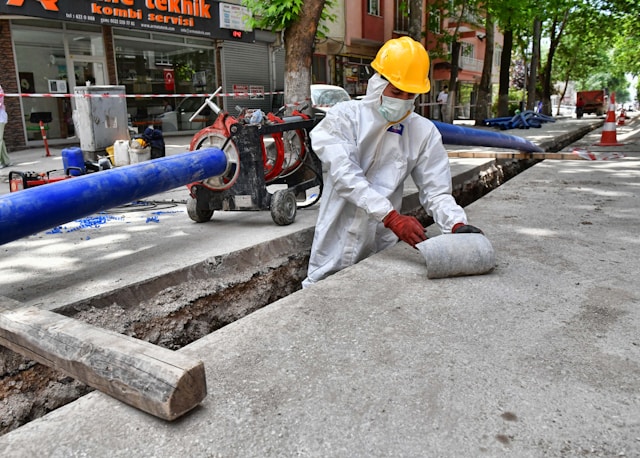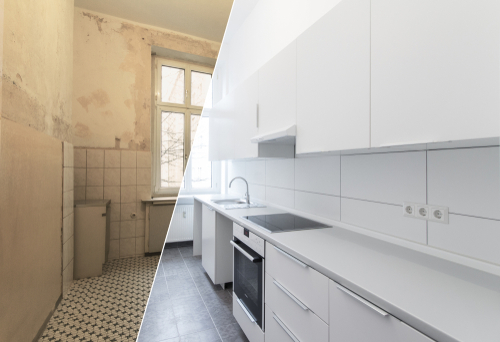What is Asbestos and Why is it Dangerous?
Asbestos refers to a group of naturally occurring toxic, carcinogenic and fibrous silicate minerals. These minerals occur in six distinct groups, all characterised by long, thin fibrous crystals. Each fibre consists of a multitude of microscopic fibrils that can become airborne through abrasion and other disturbances, posing serious health risks when inhaled.

Known for its exceptional durability, fire resistance, and insulating properties, it was extensively used in numerous industries for decades. Asbestos occurs in several forms, with the most common types being chrysotile (white asbestos), amosite (brown asbestos), and crocidolite (blue asbestos).
Why is asbestos dangerous? Asbestos is dangerous because it breaks down into microscopically thin fibres. These fibres are so small they can remain airborne for days after they were initially disturbed. While airborne, these fibres can be breathed in by every living being.
Historical Uses of Asbestos
Asbestos has been used for thousands of years, with ancient civilizations incorporating it into pottery, textiles, and construction materials. However, its industrial use surged in the late 19th and early 20th centuries, particularly during periods of rapid industrial expansion, such as World Wars I and II. Valued for its fire resistance, chemical stability, and electrical insulating properties, asbestos became a key material in shipbuilding, construction, and manufacturing, being used in a vast range of products.
Historic Common Uses of Asbestos
Because of its undoubted advantages in building and manufacturing, asbestos was used in many different products, including:
Building Materials
- Insulation: Widely used in buildings, pipes, and boilers for thermal insulation. Modern heat insulation materials include fibreglass, mineral wool, cellulose, foam insulation, and spray foam.
- Cement Products: Incorporated into cement for roofing sheets, corrugated roofing, roof slates, plaster, textured paint, pipes, and other construction materials to enhance durability.
- Floor and Ceiling Tiles: Added for strength, fire resistance, and durability.
- Roofing Materials: Used in shingles, tiles, sealants, and other roofing components for longevity and fire resistance. Shingles, particularly (tar) asphalt shingles, are used in South Africa as a roofing material, offering a cost-effective and versatile option, with various styles and colours available. They are a common and popular choice for roofing in South Africa, known for their affordability and ease of installation.
- Wallboard and Plaster: Found in drywall, plasterboard, gypsum board (Sheetrock), joint compound, and decorative plaster.
- Plumbing Materials: Used in pipes, fittings, and other plumbing components for heat and corrosion resistance.
- Flooring & Adhesives: Used in vinyl floor tiles, vinyl sheeting, and adhesives.
- Fireproofing & Heat-Resistant Products: Used in fireproofing and prevention materials, textured paints and stoves.
Friction Products
- Automotive Brakes: Asbestos was a key component in brake linings, pads, and clutch parts due to its heat resistance.
- Transmission Parts: Used in transmissions for its ability to withstand high temperatures and reduce wear.
Other Industries
- Heat-Resistant Fabrics: Used in textiles for its fireproofing capabilities.
- Packaging and Gaskets: Found in industrial packaging and gaskets for heat and chemical resistance.
- Fireproofing Materials: Used in buildings, textiles, and military vehicles to enhance fire safety.
- Sound Absorption: Utilised in construction and industrial settings to reduce noise.
South African Regulations and Safety Guidelines
Although asbestos use is now banned in South Africa, a sizable inheritance of asbestos-containing materials (ACMs) remains, particularly in older buildings and homes, posing ongoing health risks. If you are planning on undertaking comprehensive renovations of or demolishing an older or historic home, it is strongly advised that professionals are employed to undertake the task of removing any asbestos within the building.
Given the well-documented health risks of asbestos, South Africa has implemented stringent regulations to govern its use, handling, and removal. These regulations, enforced under the Occupational Health and Safety Act (OHSA) and the Asbestos Abatement Regulations, are intended to protect workers and the public from asbestos exposure.
Key Regulatory Measures include:
- Prohibition of Use. The manufacture, import, and use of asbestos in most products are strictly banned. Existing asbestos-containing materials (ACMs) must be safely managed.
- Asbestos Management Plans. Employers must develop and implement asbestos management plans for any premises where asbestos may be present. This includes conducting regular inspections and risk assessments.
- Professional Removal. Only licensed asbestos removal professionals are permitted to handle and dispose of ACMs, ensuring compliance with safety protocols to minimise exposure risks.
- Training and Awareness. Employers are required to provide asbestos-related training for workers who may be exposed to asbestos. This includes education on safety procedures, proper use of protective equipment, and exposure prevention strategies.
Strict enforcement of these regulations is essential to safeguarding public health and ensuring the responsible management/disposal of existing asbestos materials.
Asbestos Ban and Prevalence
South Africa was once a major producer and consumer of asbestos. However, in 2008, the country banned its use, manufacturing, import, and export. Despite this, ACMs – such as asbestos cement roofs – are still widely found in residential, commercial, and educational buildings.
Health Risks of Asbestos Exposure
Asbestos is a well-documented carcinogen, and inhaling its fibres can lead to severe health conditions. Once in the body, these fibres can accumulate in the lungs, leading to chronic diseases, including:
- Asbestosis: A chronic lung disease caused by long-term asbestos exposure, which causes scarring and breathing difficulties.
- Lung Cancer: Often associated with prolonged asbestos exposure, particularly among workers in high-risk industries.
- Mesothelioma: A rare and aggressive cancer primarily affecting the lining of the lungs, abdomen and heart, with a strong link to asbestos exposure.
- Pleural Diseases: Conditions affecting the lining of the lungs, causing thickening and fluid buildup.
Asbestos Abatement Regulations
To address the risks posed by legacy asbestos, South Africa introduced the Asbestos Abatement Regulations in 2020. These regulations require employers to have their workplaces inspected by a qualified asbestos inspector if workers may be exposed to asbestos. Proper management and safe removal of ACMs are mandated under these guidelines.
Managing Asbestos Safely
If you suspect that your home or workplace contains asbestos:
- Do not disturb it if the material is intact, as asbestos poses minimal risk when undamaged.
- Arrange a professional inspection if signs of damage, wear, or deterioration are present. Conduct asbestos inspections before commencing renovations or demolitions.
- Ensure safe removal and disposal by following national regulations and hiring licensed professionals if removal is necessary. Use protective equipment and follow safety protocols when handling asbestos.
- Hire licensed professionals for asbestos removal and disposal.
- Seal or encapsulate asbestos-containing materials to prevent fibre release. This should only be undertaken by trained and experienced professionals.
Safe Asbestos Removal
When it comes to asbestos removal, safety is vital. Due to the serious health risks associated with asbestos exposure, the removal process must be undertaken following strict guidelines and protocols. Steps for safely removing asbestos include:
- Assessment and Identification
Before any removal work begins, a thorough assessment of the property is essential to identify the presence and extent of asbestos-containing materials (ACMs). Professional asbestos inspectors use specialised techniques to detect ACMs in various locations, including walls, ceilings, pipes, and flooring. - Preparing the Area
Once asbestos-containing materials have been identified, the next step is to prepare the area for removal. This involves isolating the worksite to prevent asbestos fibres from spreading. Heavy-duty plastic sheeting and duct tape are commonly used to seal off the area, along with warning signs to alert occupants and workers to the presence of asbestos. - Proper Equipment and Safety Gear
Asbestos removal requires the use of specialised equipment and safety gear to protect workers from exposure. Personal protective equipment (PPE) includes:
- Respirators with HEPA filters
- Disposable overalls
- Gloves
- Boot covers
- Safety goggles
Additionally, workers must follow strict decontamination procedures to ensure that asbestos fibres do not travel beyond the work site.
- Wet Removal Techniques
One of the most effective methods for asbestos removal is the wet removal technique. By dampening ACMs with water or a water-based solution, the chance of fibres becoming airborne is significantly reduced. This method involves carefully spraying the materials with water before and during removal, thereby minimising the risk of inhalation. - Careful Handling and Disposal
Asbestos materials must be handled with care to avoid breaking or damaging them, which could lead to fibre release. Once removed, ACMs should be placed in sealed, leak-proof bags and containers for safe transportation to designated disposal facilities. It is crucial to follow local and national regulations regarding asbestos disposal, as improper or careless handling can result in serious legal and health consequences. - Post-Removal Inspection
After the asbestos removal process is complete, a thorough inspection of the worksite is necessary to ensure that all ACMs have been successfully eliminated. Air quality testing can confirm that asbestos fibres are no longer present in the environment, ensuring that the area is safe for reoccupation.
Proper management of existing materials remains essential to safeguarding public health.
Why Hiring Professional Asbestos Removal Services is Essential
Engaging professional asbestos removal services is essential due to the complexities and dangers involved in the process. Certified and experienced contractors have the expertise, specialised equipment, and understanding to safely and effectively handle asbestos removal projects. They follow stringent safety protocols and regulations, ensuring property owners have confidence and peace of mind throughout the entire process.

